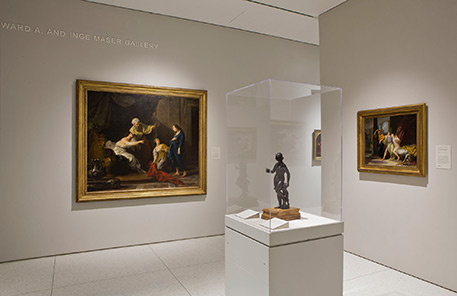European Art (2015–2016)
Edward A. and Inge Maser Gallery

Above:Installation view of the Smart's collection of European art, showing paintings by Noël Halle and Jean-Baptiste Regnault.
Top: Daphne Found Asleep by Apollo (detail), c. 1500, Oil, formerly on panel, transferred to canvas. Smart Museum of Art, The University of Chicago, Gift of the Samuel H. Kress Foundation, 1973.44.
The Smart Museum’s European collection ranges from antiquity to the nineteenth century, with particular strengths in works on paper as well as Renaissance painting, sculpture, and decorative arts.
The works on view in 2015–2016 explore key themes, movements, and artistic approaches in European art. Within a broad swath of history and geography, the groupings open deeper lines of inquiry into the devotional art of the Counter-Reformation, the role of war and nationalism in the visual arts, the durability of classical aesthetic ideals and mythology, and the real and allegorical representation of nature.
Collection rotations
A small area of the gallery is dedicated to thematic displays of prints and drawings, often presented in connection with University of Chicago courses. These installations rotate every four months to protect the works from damage caused by long-term exposure to light.
The gallery also features an ongoing display that pairs a page from Francisco de Goya’s album Disasters of War with a plate from Jacques Callot’s Large Miseries of War.
Constructing Space in European Prints
September 12, 2015–January 10, 2016
For much of the period 1500–1900 in Europe, the print medium was predominantly linear and black-and-white. Both of these factors complicated the representation of space, the theme chosen for this exhibition, which was organized by University of Chicago students—Corinna Anderson, Rachel Jackson, Amy Li, Brie McGuire, Alessandra Stamper, Jenny Chueh Wang, and Cheng Zong—following the spring 2015 course Invention and Revival in European Prints.
Art History 101: Introduction to Art
December 19, 2015–March 20, 2016
Presented in conjunction with Art 101, the introductory art history course offered at the University of Chicago, this display gathers works under two main themes: materiality, and space and the built environment. Accordingly, architectural decorations by Louis Sullivan and a tongue-in-cheek building model by Roger Brown share the space with an Art Nouveau clock and a Walker Evans photograph of the Brooklyn Bridge. Rounding out the display are two images suggesting the vitality of sculptural creation: Charles Meryon’s etching of a Gothic gargoyle, and Jean-Léon Gérôme’s painting of Pygmalion and Galatea.
Shakespeare on Paper
March 29–July 31, 2016
April 2016 marks the 400th anniversary of William Shakespeare’s death. Universally recognized as among the greatest writings in the English language, Shakespeare’s plays entered the common currency of a wider culture not just as printed texts but also in the form of images. Pictorial representations of the key plots and characters—sometimes based on specific theatrical productions, sometimes deriving from an artist’s own literary imagination—offer a different lens through which to consider Shakespeare’s achievement and enduring influence. The works on paper on display here (five prints, one drawing), selected from the Smart Museum’s permanent collection, all date from the first half of the nineteenth century—a moment of heightened attention to Shakespeare’s achievement.
